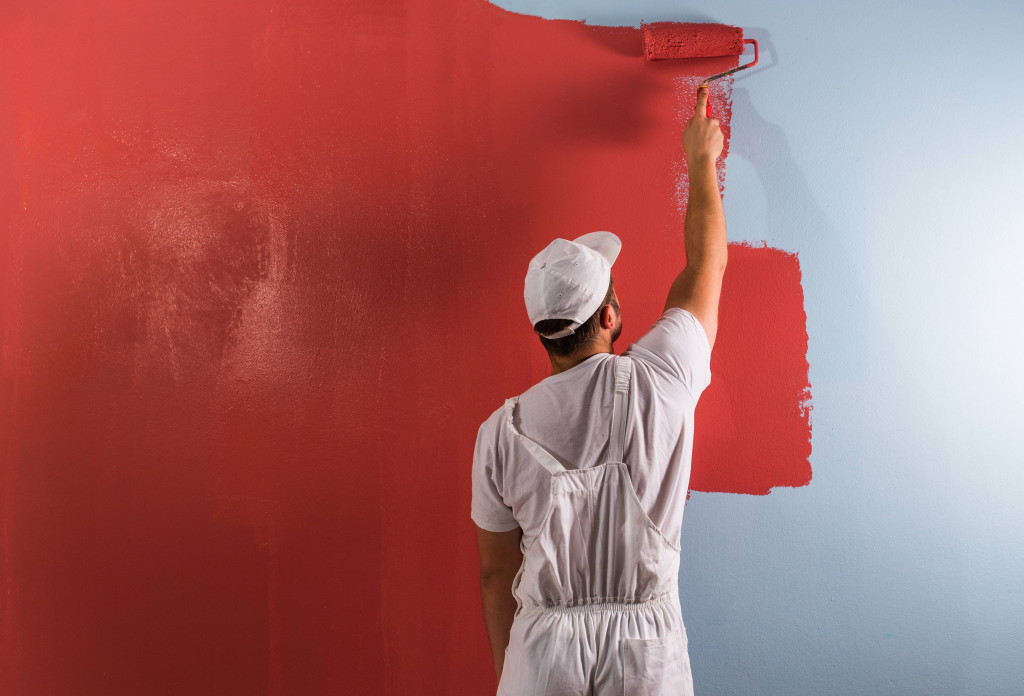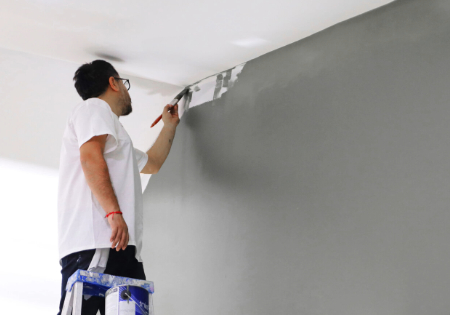Keep Ahead With New Paint Trends: Mixing Techniques for Modern Interiors

The Increase of Color Gradients in Interior Style
As designers progressively look for cutting-edge ways to enhance rooms, the increase of shade gradients in interior decoration has actually amassed considerable focus. This method, defined by the smooth shift in between two or more shades, permits for a vibrant visual effect that can transform a normal area into a vivid atmosphere. Color slopes can stimulate emotions, influence assumptions of room, and create prime focus, making them a versatile selection for different style styles.
The application of gradients extends past walls; they can be successfully utilized in furniture, textiles, and devices. Designers commonly explore varying tones to attain deepness and intrigue, attracting a series of visual appeals from minimalist to diverse. On top of that, the flexibility of slopes allows their usage in both commercial and household setups, accommodating diverse clientele. As fads advance, using shade gradients symbolizes a change in the direction of more individualized and expressive interior areas, showing private preferences and way of livings.
Embracing Ombre Methods for a Dynamic Look
Ombre strategies have become a captivating selection for those wanting to add depth and motion to contemporary interiors. This slope effect shifts efficiently from one shade to an additional, producing a visually striking prime focus in any room. Designers value ombre for its convenience; it can be related to walls, furniture, or perhaps ornamental accents, enabling one-of-a-kind expressions of style.
The method works especially well with soft tones, providing a tranquil setting, while strong shades can energize an area. Homeowners can trying out various color schemes, selecting different tones for a dramatic effect or harmonious tones for a subtle impact. The application of ombre is not restricted to a solitary wall surface; it can prolong throughout an area, improving the perception of room and light.
As a modern pattern, ombre techniques deal with diverse tastes, enabling individuals to personalize their insides and welcome creativity in their design technique. paint shops in corpus christi.
Textured Wall Surfaces: Layering Paint for Depth and Passion
Textured wall surfaces can substantially enhance the aesthetic appeal of modern interiors by including depth and rate of interest. Strategies for developing structure, thoughtful shade combinations, and the right devices for layering are vital components in accomplishing this effect. Checking out these elements enables a vibrant and individualized approach to interior decoration.
Methods for Texture Development
Creating visual passion in indoor areas typically hinges on the artful application of appearance. Various techniques can be employed to accomplish this, such as sponging, cloth rolling, and stippling. Sponging includes utilizing a damp sponge to apply a 2nd shade over a base layer, creating a soft, multicolor result. Dustcloth rolling, on the other hand, makes use of a rolled dustcloth to apply paint, causing an extra vibrant structure. Stippling uses a rigid brush or tool to swab paint onto the surface area, producing a special pattern. In addition, layering different finishes, such as matte and shiny, can enhance deepness. These methods not just give visual appeal however also contribute to the general ambiance of modern-day insides, urging a tactile experience.
Color Combinations for Influence
Layering paint not only improves appearance yet additionally opens a world of color mixes that can dramatically affect the state of mind of a room. By mixing complementary tones, designers can produce a harmonious impact that welcomes heat or coolness, relying on the wanted environment. Rich earth tones coupled with soft pastels can stimulate a tranquil environment, while strong, contrasting shades can add vibrancy and power. Furthermore, integrating shiny or metallic coatings within the layers can introduce a vibrant visual component, capturing light and enhancing the depth of the color pattern. Ultimately, thoughtful color combinations via layering paint supply a chance to express individual style while transforming common wall surfaces right into charming prime focus.
Devices for Layering Effect
Numerous tools are necessary for accomplishing a successful layering result in paint applications, which can transform wall surfaces right into bewitching visual experiences. Rollers and brushes are basic, with different dimensions permitting different textures and surfaces. Specialty devices like dustcloths and sponges can develop one-of-a-kind patterns and deepness, while scheme knives provide accuracy for even more defined lines. For larger areas, making use of a stippling brush can include a detailed coating. In addition, spray weapons can effectively use several layers for a smooth, even coat. Painters need to additionally take into consideration painter's tape to produce tidy edges between layers. By utilizing the right devices, one can successfully enhance the visual appeal of interiors, making each wall an interesting prime focus.

The Power of Shade Obstructing in Modern Spaces
As modern indoor style remains to evolve, color blocking emerges as an effective technique that can change spaces with strong visual influence. This method entails the critical positioning of contrasting shades to produce defined areas within an area, enhancing both the visual appeal and capability of the room. corpus christi tx paint shop. By utilizing big swathes of shade, designers can lead the eye and highlight building components, resulting in a dynamic atmosphere
Shade stopping is not restricted to walls; it can also be put on furniture and decoration, permitting endless personalization. Combining a dynamic shade with a neutral tone can produce a striking focal point while preserving balance. This technique motivates creativity, allowing property owners to share their characters through unique shade mixes. Eventually, shade blocking serves as an efficient means to rejuvenate contemporary insides, making areas feel fresh, energetic, and visually engaging.
Incorporating Metallics for a Glamorous Finish
Exactly how can metallics raise the refinement of modern interiors? Metallic finishes serve as a striking prime focus, adding deepness and aesthetic passion to rooms. They can transform a conventional space into an elegant resort through the refined interplay of light and representation. Designers commonly suggest incorporating metallics in accent wall surfaces, ceilings, or furniture to produce an extravagant environment without overwhelming the room.
Different metallic shades-- such as silver, gold, and bronze-- offer convenience, allowing homeowners to tailor their visual. For circumstances, a soft gold can pass on warmth, while a sleek silver can lend a modern touch. When coupled with neutral tones, metallics improve the total layout, offering a sophisticated comparison that draws the eye.
Incorporating metallic paint right into trim or moldings can likewise boost architectural details, developing a polished surface. Ultimately, the calculated use of metallics can infuse modern insides with glamour and improvement, making them truly charming.
Innovative Usage of Stencils for One-of-a-kind Patterns
Transforming walls with stencils can infuse contemporary interiors with unique personality and design. This imaginative technique enables homeowners and developers to create personalized patterns that mirror individual looks. Stencils can vary from complex geometric designs to wayward themes, enabling a vast variety of expressions. By choosing contrasting colors, patterns can boost a room's visual allure and function as centerpieces without frustrating the room.
Moreover, patterns are flexible; they can be used to numerous surface areas, including wall surfaces, furnishings, and even ceilings. This adaptability makes stenciling an optimal choice for do it yourself enthusiasts looking to boost their space cost effectively. Furthermore, the simplicity of application and removal enables testing, allowing individuals to rejuvenate their style with marginal initiative. Eventually, innovative use stencils not only transforms ordinary surfaces but also supplies an opportunity for self-expression, making them a trending option in contemporary interior decoration.
Mixing Matte and Glossy Surfaces for Comparison
The interplay of matte and glossy coatings can develop a striking aesthetic dynamic in modern-day interiors. Developers frequently use this comparison to improve building attributes and specify spaces. Matte coatings, with their soft, non-reflective high quality, can create a feeling of warmth and affection, making them optimal for walls and bigger surfaces. In contrast, shiny surfaces mirror light, adding vibrancy and deepness, making them appropriate for accents such as trim, moldings, or furnishings.
The combination of these structures can assist the eye and stress centerpieces within a room. Coupling a matte-painted wall surface with glossy cabinets can produce an innovative equilibrium. In addition, the mindful application of both coatings can evoke different state of minds while enhancing the general visual. As get more info home owners increasingly look for customized rooms, blending matte and glossy finishes offers a functional technique to accomplishing modern sophistication and aesthetic passion in indoor design.
Often Asked Inquiries
What Devices Are Best for Mixing Paint Techniques?
A selection of devices are ideal for mixing paint strategies, including foam rollers, brushes with soft bristles, sponge applicators, and airbrushes. Each device offers one-of-a-kind results, improving the mixing procedure for different imaginative applications.
How Can I Fix Mixing Mistakes?
To fix mixing errors, one should lightly sand the affected location, apply a primer if needed, and afterwards meticulously reapply paint making use of a soft brush or sponge to attain a smooth change and bring back the preferred impact.
Are There Particular Paint Brands Recommended for Blending?
Several paint brands are suggested for blending, including Benjamin Moore, Sherwin-Williams, and Behr. These brand names provide high-quality coatings and a variety of colors that help with smooth shifts and reliable mixing techniques in different indoor tasks.
Can I Mix Paint Without Specialist Aid?
Yes, mixing paint without expert help is possible. With technique and the right devices, individuals can achieve preferable impacts. Various online tutorials and overviews can help in mastering mixing techniques for individual tasks.

For How Long Does Blended Paint Last on Walls?
Combined paint can last anywhere from 5 to 10 years on wall surfaces, relying on variables such as the quality of paint utilized, surface area preparation, and environmental problems. Routine upkeep usually boosts longevity and appearance.
As designers increasingly seek ingenious means to boost spaces, the surge of shade slopes in interior style has actually garnered considerable attention. The method works specifically well with soft shades, providing a tranquil atmosphere, while vibrant shades can invigorate an area. Strategies for developing texture, thoughtful color combinations, and the right tools for layering are vital elements in attaining this effect. Layering paint not only enhances structure yet also opens up a world of shade combinations that can dramatically affect the state of mind of a space. As modern-day indoor design proceeds to progress, color blocking arises as a powerful technique that can change spaces with vibrant visual impact.